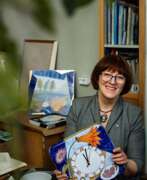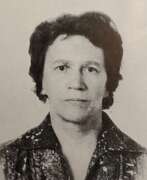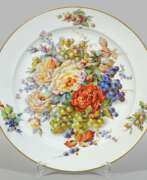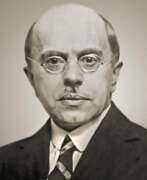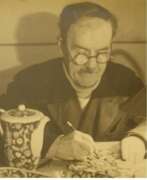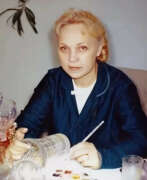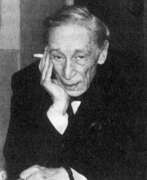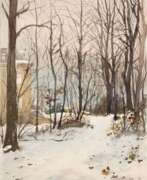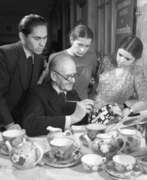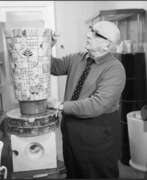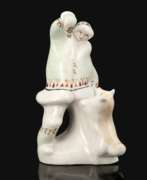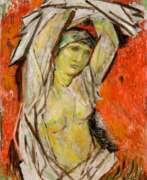Porcelain painters


Albert Samuel Anker was a Swiss painter, gesture painter and graphic artist.
Albert studied at the École Nationale Supérieure des Beaux-Arts in Paris and exhibited his work at the Paris Salons, where he was awarded a gold medal in 1866. Anker painted many realistic portraits and genre scenes of ordinary Swiss life. In many of them he depicted children, including his own. Thanks to his paintings, Albert Anker was the most popular genre painter of 19th century Switzerland. He also decorated more than 500 earthenware plates for the Alsatian ceramicist Theodor Deck.
Anker was a member of the Grand Council of the Canton of Bern, initiated the creation of the city museum, and held the rank of officer of the Legion of Honor.


Charles Garabed Atamian is a French artist of Armenian origin born in Turkey.
He studied for a time at the Academy of Fine Arts in Venice, then worked as chief designer at a porcelain factory in Istanbul. In 1894, Atamian worked with a team of artists to decorate the new palace of Sultan Abdul-Hamid Il in Yildiz, on the European side of the Bosphorus. He designed, among other things, the patterns for the ceramic tiles of the palace walls.
In 1897, Atamian emigrated to France and began illustrating books and magazines, as well as working on sets for several Parisian theaters. Since 1903 Atamian participated in various exhibitions with unquestionable success. He painted landscapes, sea and beach scenes with children (including some 200 paintings at Saint-Gilles in the Vendée, where he resided each year during the summer months from 1923 to 1939). Throughout his career he was a fine portrait painter. He became a member of the National Society of Artists in 1927.


Jean-Jacques Bachelier was a French painter and innovator of porcelain and a member of the Royal Academy of Painting and Sculpture.
Originally a still-life painter, he later became world-renowned for his significant contributions to applied art. In 1765, Bachelier founded an art and crafts school in Paris with his own funds. He was in charge of the painters at the porcelain manufactory in Vincennes, where figures were produced from unglazed porcelain - biscuit. For many years Bachelier was the Director of Sevres porcelain manufactory and in fact became the creator of the Sevres style.
Bachelier also conducted research on encaustic painting (a painting technique in which the binding substance of paints is wax) and published works on art education.


Joseph Birbeck I was a renowned English ceramic painter born in 1862. He was known for his exquisite work on bone china and porcelain, especially with designs that feature intricate fish, game birds, and landscapes. Birbeck's career highlights include his contributions to Royal Doulton and other renowned potteries in Staffordshire, England.
His artistry is well-regarded, with various hand-painted works sold at auction and featured in private collections. Some of his notable pieces include Royal Doulton bone china fish plates made for Tiffany & Co., New York, often hand-painted with intricate fish designs and signed "J. Birbeck, Sen."
Several works by Birbeck are highly valued by collectors and are found in prestigious auction houses and antiques marketplaces. If you're interested in collecting his works or learning more about them, you can find a range of his pieces, such as ornithological cabinet plates and decorative vases, at various auctions and antique dealers.
For those interested in exploring the art and history of Joseph Birbeck I, there are numerous platforms where you can track his pieces and find upcoming sales. Consider signing up for updates on upcoming sales and auction events focused on Birbeck's art. This subscription will keep you informed about new product releases, exclusive collectible items, and related news in the field of art and antiques.
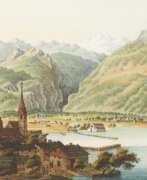

Johann Heinrich Bleuler the Elder was a Swiss landscape painter and engraver.
Bleuler the Elder first trained as a porcelain painter at the Kilchberg-Schooren porcelain manufactory near Zurich. In the early 1780s he settled in Feuertalen and became the founder of the dynasty of artists that is known as the "Bleulerische Malschule". His two sons, Johann Heinrich Bleuler the Younger (1787-1857) and Johann Ludwig Bleuler (1792-1850), also became artists and continued their father's work. And in total, there were up to 25 artists in the dynasty, including godchildren and other relatives.
Bleuler the Elder created mainly landscapes of the Rhine, painted in gouache and watercolor, panoramic views of Swiss cities. He also worked as an art teacher.


Louis-Alexandre Cabié was a French landscape painter.
He was inspired by charming views of the French provinces. He painted many landscapes of the Charente near Cognac, the banks of the Gironde, Royan, and the cliffs of Saint-Georges-de-Didon, as well as on the banks of the Weser. Cabié also painted his landscapes on vases at the Vieillard ceramics factory in Bordeaux.


Ilya Grigorevich Chashnik (Russian: Илья Григорьевич Чашник) was a Russian Suprematist artist, known for his close association with Kazimir Malevich and as a pioneering member of the UNOVIS school. Born in 1902 in Lucyn, Russian Empire (now Ludza, Latvia), Chashnik's artistic journey began in Vitebsk, where he was deeply influenced by the avant-garde movements of the early 20th century. He studied at the Vitebsk Artistic-Practical Institute under Malevich and became one of his most faithful disciples, embracing Suprematism's focus on basic geometric forms and the use of a limited color palette.
Chashnik's work is characterized by his exploration of Suprematist principles across various forms of art, including painting, metalwork, and ceramics. His art is distinguished by a dynamic use of forms, often incorporating complex tonal relationships and achieving a sense of rhythm and symmetry. Notably, Chashnik applied these principles to the design of everyday objects, making significant contributions to porcelain design at the Lomonosov Porcelain Factory. His designs for the factory revealed his inventive approach, combining Suprematist aesthetics with practical applications.
Despite his untimely death in 1929 at the age of 27, Chashnik's legacy in the art world remains profound. His works are held in several prestigious collections, including the Thyssen-Bornemisza Museum in Madrid and the Museum of Modern Art (MoMA) in New York. These institutions recognize Chashnik not just for his artistic output but also for his significant role in the development of Suprematism and its application beyond traditional canvases.
For those interested in the intersection of avant-garde art and practical design, Ilya Chashnik's work offers a fascinating study. His ability to translate the visionary ideas of Suprematism into tangible objects marks him as a key figure in the movement's history. To stay updated on new insights and sales related to Ilya Grigorevich Chashnik's work, sign up for updates and don't miss out on the opportunity to explore the works of this groundbreaking artist.




Jean-Charles Develly is a French designer and artist. He is particularly famous for his paintings on porcelain while working at the Sèvres factory. Jean-Charles Develly worked at the Porcelain Manufactory in Sevres from September 1813 to 1847 and became one of the most famous artists of this establishment.


Johann Baptist Drechsler was an Austrian floral artist. He was born into a family of porcelain painters and worked for ten years at the Viennese porcelain manufactory. He is known for his colorful floral still lifes, including fruit and birds.


Frédéric Théodore Faber was a Belgian landscape and genre painter. He established at Brussels a china manufactory, and abandoned painting on canvas for painting on porcelain. He also etched upwards of a hundred plates of landscapes and animals, some after his own designs.
A significant set of pieces painted by this virtuoso is exhibited at the Museum of Decorative Arts François Duesberg.


Jean-Baptiste Fresez was a German painter of French origin.
He began his studies at the Luxembourg School of Drawing and then continued at the Royal Academy in Brussels and obtained Luxembourg citizenship. Fresez worked as an engraver and painter at the Villeroy and Boch porcelain factory in Mettlach on the Saar River, and from 1824 he successfully taught at the Luxembourg Drawing School.
Fresez produced beautiful landscapes and very lively portraits. These are mainly of members of the Grand Ducal family and other well-known local personalities. A collection of 30 lithographs was published based on his landscape drawings, which today are considered very valuable in documentary terms, and each of them has a detailed description. Fresez's landscapes are characterized by their almost photographic depictions of the city of Luxembourg. After the publication of this work, he was elected a member of the Archaeological Society of the Grand Duchy.
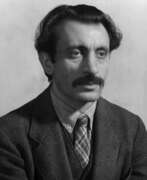

Arshile Gorky was an Armenian-American painter who had a seminal influence on Abstract Expressionism. He spent the last years of his life as a national of the United States. Along with Mark Rothko, Jackson Pollock and Willem de Kooning, Gorky has been hailed as one of the most powerful American painters of the 20th century. The suffering and loss he experienced in the Armenian genocide had crucial influence at Gorky’s development as an artist.


Elena Graure-Manta is a Romanian glass and porcelain artist based in Germany.
Elena studied under the glass and porcelain artist Clausenburg (Romania), at the Romanian Academy of Fine Arts, and worked as a designer for the Avrig glass manufactory. In her work, she takes objects from everyday life as a basis and, endowing them with her imagination, creates glass works of art from them. In this way Elena Graure-Manta created a series of glass shoes and handbags, and later glass "luxury cars". Graure-Manta's glass objects are very colorful and contain many details, making each piece unique and interesting.
From 1995-2005, the artist owned the Vitrumex glass manufactory in Romania and works in her own studio in Erftstadt, Germany, near Cologne.


Carl Friedrich Heinzmann was a German landscape painter, porcelain artist, lithographer, and printmaker. He worked for the Nymphenburg Porcelain Manufactory and mostly painted serene and peaceful landscapes. Heinzmann also left lithographs and oil paintings, many of which describe war scenes.


Johann Gregor Höroldt was a German porcelain artist who developed the Meissen porcelain style. Höroldt was trained as a miniature and enamel painter.
Between 1719 and 1720 he worked at the porcelain manufactory in Vienna, recently founded by Du Pacquier, and then moved to Meissen and began his collaboration with the Meissen Porcelain Manufactory. In 1724 he was appointed court painter. In 1731, Höroldt became an arcanist (a chemist, a key figure in porcelain production), and was simultaneously appointed head of the entire painting department and court commissioner.
Höroldt influenced virtually all European porcelain and faience manufactories. He specialized in the fashionable and popular chinoiserie design, but also introduced European landscapes, harbor and battle scenes, still lifes, and bird images as porcelain decoration.
The artist also significantly expanded the palette of colors used in Meissen: in the early XVIII century. was available only five paints for glaze, and Höroldt by 1731 increased the palette to 16 colors. He attached great importance and the original form for porcelain, trying to make it different from the usual dishes.




